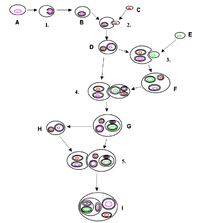
Photo from wikipedia
Interactions between microbes and their hosts have important outcomes for host and environmental health. Foliar fungal endophytes that infect healthy plants can harbor facultative endosymbionts called endohyphal bacteria, which can… Click to show full abstract
Interactions between microbes and their hosts have important outcomes for host and environmental health. Foliar fungal endophytes that infect healthy plants can harbor facultative endosymbionts called endohyphal bacteria, which can influence the outcome of plant-fungus interactions. ABSTRACT Symbiosis with bacteria is widespread among eukaryotes, including fungi. Bacteria that live within fungal mycelia (endohyphal bacteria) occur in many plant-associated fungi, including diverse Mucoromycota and Dikarya. Pestalotiopsis sp. strain 9143 is a filamentous ascomycete isolated originally as a foliar endophyte of Platycladus orientalis (Cupressaceae). It is infected naturally with the endohyphal bacterium Luteibacter sp. strain 9143, which influences auxin and enzyme production by its fungal host. Previous studies have used transcriptomics to examine similar symbioses between endohyphal bacteria and root-associated fungi such as arbuscular mycorrhizal fungi and plant pathogens. However, currently there are no gene expression studies of endohyphal bacteria of Ascomycota, the most species-rich fungal phylum. To begin to understand such symbioses, we developed methods for assessing gene expression by Pestalotiopsis sp. and Luteibacter sp. when grown in coculture and when each was grown axenically. Our assays showed that the density of Luteibacter sp. in coculture was greater than in axenic culture, but the opposite was true for Pestalotiopsis sp. Dual-transcriptome sequencing (RNA-seq) data demonstrate that growing in coculture modulates developmental and metabolic processes in both the fungus and bacterium, potentially through changes in the balance of organic sulfur via methionine acquisition. Our analyses also suggest an unexpected, potential role of the bacterial type VI secretion system in symbiosis establishment, expanding current understanding of the scope and dynamics of fungal-bacterial symbioses. IMPORTANCE Interactions between microbes and their hosts have important outcomes for host and environmental health. Foliar fungal endophytes that infect healthy plants can harbor facultative endosymbionts called endohyphal bacteria, which can influence the outcome of plant-fungus interactions. These bacterial-fungal interactions can be influential but are poorly understood, particularly from a transcriptome perspective. Here, we report on a comparative, dual-RNA-seq study examining the gene expression patterns of a foliar fungal endophyte and a facultative endohyphal bacterium when cultured together versus separately. Our findings support a role for the fungus in providing organic sulfur to the bacterium, potentially through methionine acquisition, and the potential involvement of a bacterial type VI secretion system in symbiosis establishment. This work adds to the growing body of literature characterizing endohyphal bacterial-fungal interactions, with a focus on a model facultative bacterial-fungal symbiosis in two species-rich lineages, the Ascomycota and Proteobacteria.
Journal Title: mSystems
Year Published: 2022
Link to full text (if available)
Share on Social Media: Sign Up to like & get
recommendations!